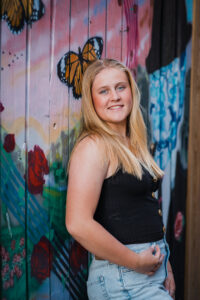As a child, Hannah Geiser felt the need to hide the feminine side of herself, so she could excel at soccer, but as she grew, she realized that she was hiding part of herself.
This blog is part of the ongoing Learn, Pray, Join: Undoing Patriarchy series.
 Hannah Geiser attends Laurel Street Mennonite Church in Lancaster, Pennsylvania. She is a student at Mount St. Mary’s University, where she studies international relations and plays Division I soccer.
Hannah Geiser attends Laurel Street Mennonite Church in Lancaster, Pennsylvania. She is a student at Mount St. Mary’s University, where she studies international relations and plays Division I soccer.
______________________________
I was five years old when I put on my cleats and shin guards for my first ever soccer practice. I was also five when my grandmother wanted to measure me for a dress that she wanted to make for me. The former of those two memories is one of my favorite memories from the first 10 years of my life — the memory of those first excited butterflies has carried me all the way to playing collegiate soccer now. The latter was an instance that I avoided at all costs throughout my childhood and into my tween years. I did not want to wear a dress. Even at five years old, I understood that soccer and femininity didn’t mix, and I carried that with me for a very long time.
It certainly was not that I was not a feminist. I stood up to a substitute teacher in gym class, who told the girls to do fewer pushups, when I was in fourth grade, and I confidently told anyone and everyone that girls can do anything boys can do. Despite my beliefs, I still held tightly to a piece of the patriarchy that we are just now starting to see unravel: Sports are a distinctly masculine activity.
I grew up playing with two brothers, all boy cousins and the middle school boys my dad coached, who I practiced with more often than not. From running races on the beach in the summer, to playing soccer with boys twice my size and age, almost all of my interactions with sports were through a masculine lens. I rejected wearing dresses, I wore my hair up in a ponytail, I wore soccer shoes to school, and I definitely did not sit for my grandma to fit me for a dress. I secretly didn’t entirely hate it. I liked the way I felt when I wore a dress to my fifth-grade graduation and when I got my makeup done for the musical.
I was entirely unable to reconcile those two parts of myself, and because I wanted to be good at soccer, I buried the feminine part of me deep down.
My aversion to femininity was certainly not only due to my individual circumstances. Media coverage of women’s sports was phenomenally low; there was nowhere for me, or any other female athlete, to truly see ourselves in the broader picture of sports. It was the 2019 Women’s World Cup, held in France, that opened the door for me to see how soccer and femininity were not opposing identities. It allowed me to see not only how they could exist in tolerance with each other but how they complemented each other in an interconnected way. When I saw Marta, arguably the best women’s footballer in the world, wearing her red lipstick; another player with false lashes on; and another with a cheetah print hairstyle on her shaved head, something in my brain started to turn. If these women were playing at the height of their sport, and being distinctly feminine, athleticism and femininity could not be opposing.
As with most things that we learn about ourselves and the world that are also ingrained in patriarchy, my unlearning did not happen overnight. My drawers were filled with athletic wear only, so I couldn’t have immediately switched my wardrobe, even if I wanted to. I hadn’t ever worn makeup, so I missed out on the awkward middle school phase of figuring out my style. Ever so slowly, however, I did start to choose different kinds of clothes, and in the middle of high school, I started wearing mascara for the first time. Far from taking away my ability to play soccer, as I had feared that it would, it, instead, made a more confident player. I wasn’t just an athlete; I was a female athlete.
As I’ve entered college, playing Division I soccer, this distinction has been central to my identity. I have learned to embrace my own femininity and found that my strength is distinctly feminine. My body gets stronger in different ways than the men I grew up playing soccer with, and soccer is played differently across the different genders — a topic I would gladly talk someone’s ear off about, if they let me. But while some parts are distinctly and especially different for a female athlete, the emotions of sports that have been branded as masculine emotions are ones female athletes, like myself, are reclaiming.
Pride, hunger, passion and anger are not masculine emotions. They are human emotions. My experience of soccer, and of sport, includes pride in myself and my team when we do well, the hunger to win, the anger when I lose or when the other team infuriates me, and the passion to love the sport as much as I do. These emotions are an expression of myself, as a human and as an athlete. I also put on mascara before games and wear pink bows in my hair with my teammates in a game, while also being hungry to win, passionate and sometimes angry. These expressions of sport and of femininity exist together, and they make me who I am: A female athlete.

“Learn, Pray, Join: Undoing Patriarchy” draws attention to the ways in which the current systems in our world and churches create spaces that perpetuate patriarchal norms and do harm to those who fall outside of those norms. This initiative provides tools and resources to help MC USA church communities work toward a more equitable world, in which everyone is treated with the care and respect they deserve, regardless of gender.
You are invited to get involved with Learn, Pray, Join: Undoing Patriarchy.
Support Mennonite Church USA’s Peace and Justice Initiatives by giving here.
The views and opinions expressed in this blog belong to the author and are not intended to represent the views of the MC USA Executive Board or staff.

